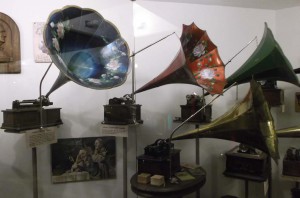
Acoustic phonographs and electrically amplified jukeboxes face each other from across the walkway of the Museum gallery, not unlike an alley scene straight out of “West Side Story”. If they had fingers, they would be snapping them menacingly in time with the beat projecting out of their horns and speakers, respectively. The heightened drama of this standoff, one audio technology superseded by another, shouldn’t be lost to visitors of the Music House Museum in Williamsburg, Michigan. Although the display is fantastic, it is hardly the most impressive sight to be seen and heard.
The Music House, a 30 plus year old non-profit museum, is home to one of the larger publicly accessible automated musical instrument collections in the United States, and it is sitting in your backyard. “Automated”, meaning that they are instruments that literally play themselves! Visitors are welcome to explore the vast collection of music reproduction technology found within the 1910 dairy barn and gallery that comprises the public space of the Music House Museum located on the remaining 7 acres of the Stiffler Family farm.
In addition to the instruments already named, you’ll find examples of early radios, 200 year old barrel organs and Turkish and Spanish barrel pianos, American reed pump organs, two pipe organs, European fairground and dance organs, a Bavarian organ clock, Milton and Duo Art player and reproducing pianos, several example cylinder and disc music boxes, a rare Lochmann Original 450 disc piano, European and American nickelodeons, and other examples of instruments “featuring mechanical music reproduction some of which predate electricity, Bruce Ahlich, Board Vice-President and Collections Committee Chairman states that “an important aspect of the Music House Museum, unlike some similar venues, is that if the instrument was not originally electronically amplified or powered, it normally remains so in our collections”.
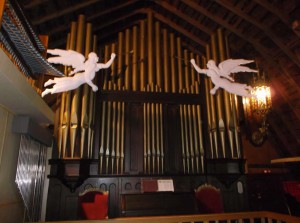
Not only does Ahlich and his Committee oversee collections maintenance and acquisition of new items, he is also an accomplished local organist who played the dedication recital on the Estey pipe organ acquired in 1988 from St. Andrew’s Roman Catholic church in Saginaw, now located on the raised deck at the Museum and used to demonstrate a Wagnerin organ roll player. Much of the maintenance and minor restorations of the Museum’s collection of unique instruments takes place on-site in its Workshop. Larger projects are usually contracted out to outside specialists who engage in that particular type of work.
“Our goal is always to seek to restore the instrument as close as possible, given available materials, to its original condition, which can be a time consuming and expensive proposition”, further states Ahlich. “Electronic sound reproduction can never replace the experience of an acoustic instrument being played”.
“We could put CD players with hidden amplifiers in the instruments at a lot less expense, but what kind of Museum would we be and what type of musical experience would our guests have”? The Music House Museum prides itself in having a majority of the displayed instruments playable with the major instruments demonstrated on every tour to its patrons.
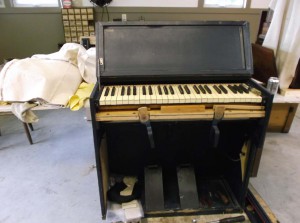
Local restoration and repair of instruments is done in a workshop off to the side of the main building by hired and volunteer staff. Among projects underway is work on the Museum’s Seeburg KT nickelodeon and restoration of an Estey chaplain’s portable reed organ probably used in World War II. The Workshop also stores other automated instruments waiting for funding to be restored. The workshop construction was paid for by a Rotary Charities grant in the mid-90s, and the volunteers remain grateful for that and other bequests to the Museum. Without this kind of assistance, and funding from individual donors, the Music House could not be what it is, a truly unique museum of musical craftsmanship dedicated to the preservation and education about a type of music that lifts the soul and gives a window to the listener to the past. Earnings for a Museum instrument purchase/repair endowment fund assist with restorations, but often do not cover their full costs.
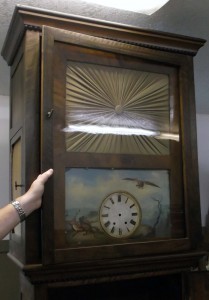
A fun piece currently being restored is a scarce Bavarian Black Forest floor cabinet organ clock, not yet ready for display that dates from the 1830s. The principle challenge in this restoration project has been finding a suitable clock mechanism as the original had been long removed before it was received by the Museum. The piece has stood silent for several decades on display in the Museum galleries. An English clock mechanism has been found and will be installed by local and nationally known clock artisan, Nathan Bower, together with a new clock face this winter. When reassembled, the clock will chime the hour and then trigger a small two-rank barrel pipe organ to play. Ahlich states, “we are really looking forward to have this piece greet our visitors in the lobby when we reopen in for the 2015 season in May.” This project will cost approximately $2,500 to complete.
While the restored clock will be impressive, the original assembly was equally remarkable, as Bruce describes: “In slow winter months, a village collective would develop between neighbors in the Bavarian region of modern Germany, and a cottage industry creating these intricate clocks was born. Each farmer or craftsman would work on his part; some would be responsible for the wood cabinet, others would build the clock, others craft the face and others build the organ and its mechanism, and finally a last person would assemble the whole clock together.” We might pride ourselves on being a do-it-yourself culture, but I’d say those Bavarian artisans have us beat without the benefit of electricity or computers.
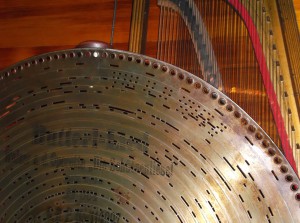
That doesn’t mean we can’t appreciate beautiful craftsmanship when we see it! Take the Lochmann Original 450 disc piano from 1904 on display in the Hurry Back Saloon, a section of the barn restored to appear as an old-timey watering hole and general store. This piece, among the rarest in the Museum’s collections, represents an innovative step in automated instruments and a natural evolution of the disc music box. Before, craftsmen would (expensively) create music boxes by inserting hundreds of pins individually on to metal cylinders; The pins would pluck pitched combs as the cylinder rotated, and the box would play the inscribed melody. The disc music box uses stamped steel discs to achieve the same effect at a much reduced price tag. The Lochmann Originals takes the next step by moving the technology to play a 44 note piano and 12 note chime mechanism. These instruments were built for a relatively short period of time (less than a decade) and as such are scarce and rare to find in playing condition. They, together with other disc instruments, were replaced by the player piano and the developing phonograph by 1908-10. Also silent for many years, the Lochmann is now tuned and playing. Bruce played a waltz for us using one of the original discs, to show how the hand cranked 150 lb. stone in the back of the cabinet powered the disc movement to create the music. Worth the 10 Pfennings this coin-operated machine would have cost you? You bet!

Not every piece in the Music House is a miracle of invention. Acquired by the Music House in the 1990s, stored for over a decade on the top shelves in the Workshop and finally rediscovered and reassembled and largely restored in the fall of 2013, the cabinet organ pictured here is a fantastic amateur effort to build a home pipe organ. How amateur? Well, the maker forgot to build a place to rest music on.
In addition to that revelation, Museum restorer (Jim Gruber) determined that whoever built the organ was likely a skilled European cabinet maker living in the Southern United States about the time of the Civil War. How did he get all that information from boxes of disassembled parts and cabinetry? The type of wood used to build the cabinet was grown in the South, tulip poplar and gumwood; the keys are made from cow bone, which also places its manufacture in the United States; the maker was not a professional organ builder, as scrap wood and leather was used throughout and the interior shows many efforts at reworking the placement of the organ in the cabinet. Pages from an old atlas were used to seal the bottom of the wind chest; the paper in question was taken from an atlas (Olney’s School Geography and Atlas), and have been dated to circa 1844 by the edition numbers found on them. Finally, the maker was likely European, as the notes inscribed on the pipes for their pitches and the cabinet measurements all fit European standards. Restorers and sleuths, the volunteers at the Music House display a variety of talents.
Grand Traverse Journal will feature the Music House again in the spring, when the 1913 Bruder Fair Organ “Columbia” will be back from Ohio, where it is currently undergoing a $12,000 professional restoration that could not be done in-house. A generous $5,000 matching gift, some Endowment monies and private donations have enabled to Museum to fund the project, as well as acquire some new music book stock by which to play it.
Hurry, the Music House Museum closes January through April, so enjoy the sounds of the season any weekend in December! Decorated for the Christmas season, as docent Becky Gagnon says, “There is a magical feeling every time you walk in!” The Museum is also open the week between Christmas and New Years from 10 am to 4 pm with continuous docent led tours. A community open house with refreshments and reduced admission ticket prices is planned for Sunday December 21st 12 noon to 4 pm, where all of the instruments will be demonstrated on a rotating basis playing Christmas music if it is available for them.
Amy Barritt is co-editor of Grand Traverse Journal. This article could not have happened without the generosity of Bruce Ahlich of the Music House Museum. Thanks Bruce!


On behalf of the Music House Museum Board, thank you so much for the article and pictures. We are most grateful for the promotion and interest your web article will create, especially since we are fund-raising for a new roof to be put on in the spring of 2015. 🙂
GTJ is always pleased to feature our local history treasures, like the Music House Museum! I enjoyed my tour beyond words, so much thanks to the Board for all your hard work. It’s the giving season, and I recommend everyone give themselves a wonderful afternoon at the Music House!